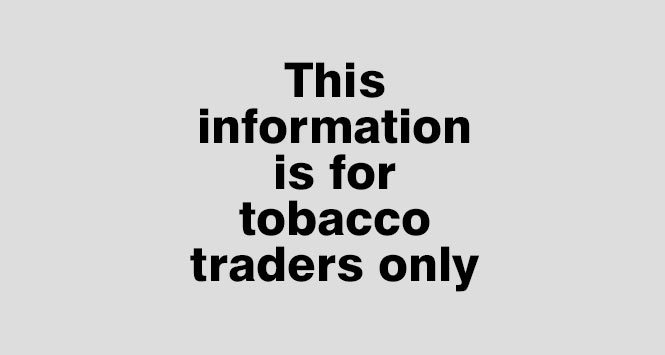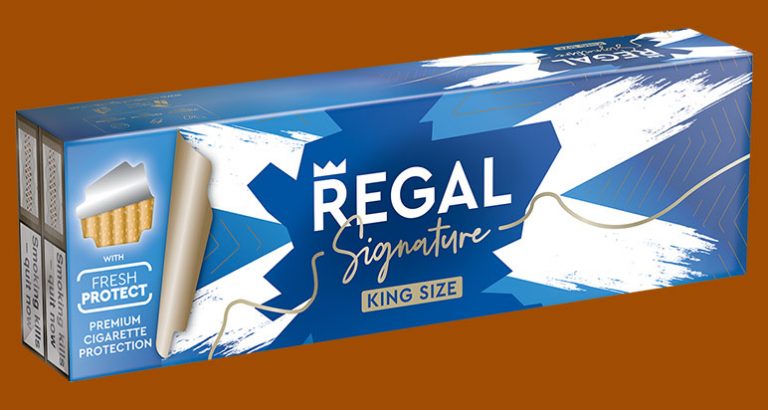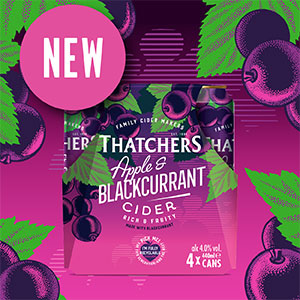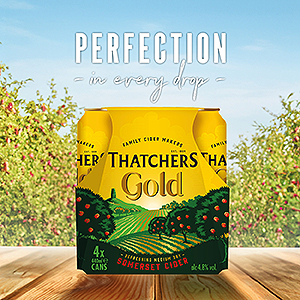As retailers get used to the tobacco display ban, there has already been talk of the next retail challenge. The EUTPD regulations, which will be enforced next year, will see UK retailers forced to adopt a number of EU-wide restrictions on the sale of tobacco.
by Émer O’Toole
Following the introduction of the display ban, retailers are set for further disruption from next year when EUTPD 2 regulations come into force. The message from suppliers for now is a simple one: maintain 100% product availability at all times. At the end of the day, if a product is not in stock, customers will go elsewhere and may not return, which will impact sales.
To recap, the EUTPD 2 will prohibit the sale of cigarettes in packs of less than 20 and RYO in packs of less than 30g. All products will require pictorial health warnings to cover 65% of the front and back of packs. The minimum dimensions for cigarette packs will lead to the end of slim ‘lipstick’-style cigarette packs. No promotional elements will be allowed on packs. This includes references to taste or flavourings or their absence (additive free). Similar rules will apply to RYO tobacco packs, which will also have to carry 65% combined health warnings on the front and back as well as the additional text warnings.
All of this is expected to lead to a 2% decrease in consumption of tobacco over a period of five years – the equivalent of 2.4 million fewer smokers in the EU.
This further disruption so soon after the display ban will provide a huge challenge for retailers after enforcement in May 2016, though suppliers have a year to sell through existing stock. Imperial Tobacco surveyed independent retailers in relation to the aftermath of the display ban in the UK between April-June this year. Overall, early indications from the study suggest that the display ban is having little effect on sales or brand choice, but it’s worth noting that around a fifth of smokers are spending more time at retailers’ counters making their purchase, thereby slowing transactions times and possibly causing frustrations for non-smokers in line.
The research also revealed that both FMC and RYO customers have generally stayed loyal to their regular retailer(s) since the display ban. Around a quarter of smokers have changed their behaviour around products purchased post display-ban. The largest single change is that nearly a fifth now ask for display unit doors to be opened to aid choice.
Jeremy Blackburn, JTI’s Head of Communications, says that retailers who were better prepared for the ban “eased into it.” He adds: “The ones who prepared early had time to attune, ensuring staff were trained and familiar with where everything was, which allowed for a smooth transition and was positive for consumers.” JTI has pledged to support and communicate with retailers ahead of the EUTPD changes.
The company’s ARTIST (Availability, Range, Training, Innovation, Sales and Technology) plan continues to advise retailers on how to maximise profit from tobacco. Blackburn says: “We’ve launched JTI Advance which is a great mechanism for communicating with retailers and we have 200 sales people out there seeing retailers every four weeks – those visits are a good opportunity to speak to the rep about the category, brands and any concerns they may have. A lot of it comes down to stock rotation.”
Since the display ban, consumers have been more specific when buying tobacco. Only 3% now ask for the cheapest brand and about 4% of consumers now describe their brand in more detail when purchasing in a post-display ban environment. Products such as Break Filter Cigarillos, available in price-marked packs of 17 sticks for £4.59, allow retailers to offer their customers a cheaper, alternative value for money smoke.
Sales rolling in for accessories
Despite drastic changes in the tobacco market, the UK’s £242m RYO accessories market is maintaining a loyal following, with filter tips being one of the best-performing products, valued at £65m.
Gavin Anderson, General Sales Manager for leading RYO accessories supplier Republic Technologies (UK), says the “combination of value, choice and quality of RYO accessories is proving attractive to consumers.”
Swan leads the filter sector, growing at almost three times the total market, with year-on-year sales up 3.6%.
Republic Technologies’ Zig-Zag brand remains a key player in the rolling papers sector, with product innovation and high-profile marketing activity driving growth.
The brand’s recent NPD has focused on activity that taps into key consumer trends. For example, the Ultra Slim Swan filter provides RYO enthusiasts with a smoother taste and enhanced tobacco flavour.
The recently launched ‘Zig Zag Rolling With…’ music promotion will give millions of fans behind-the-scenes access into the lives of Grammy award-winning La Roux and the Welsh rock band, Catfish and the Bottlemen.
Post-display ban sales seem to have remained steady. There has been no real shift to the supermarkets and the move to smaller pack sizes and VFM brands has not speeded up after the display ban. Only 1% of consumers claim to have changed outlet or brand as a consequence of the display ban, so popular brands that consumers know and trust should have a strong presence in a retailer’s tobacco gantry. It’s likely that unfamiliar products that are new or not big sellers may be rationalised out, meaning that stocking popular brands will be of even greater importance. As a result, stocking market leading brands like Café Crème will be key to maintaining cigar sales in a dark market. However, the emphasis is on retailers to identify the right range for their store, based on the products rate of sale and customer base, and adjust their range accordingly.
TPD2 regulations will come into effect in May and will ban sub-30g packs. Smaller packs continue to drive sales in convenience in general so retailers should make the most of the 12.5g and 25g sizes while they are still legal. 12.5g is the largest pack variant on the market, accounting for £775m of the value, 25g for £650m – £1.45bn of the total. Make sure brands such as NAS are stocked to offer niche products and gain margin from the premium price point. The last two years has seen a range of smaller pack sizes being launched – 8g, 9g, 10g, 20g, etc. This has been to hit certain price points and to try and encourage brand switching in advance of the TPD.
With the tobacco display ban likely to de-normalise tobacco, and plain packaging considered easier to replicate, there are fears that the illicit trade will benefit. According to a KPMG report, the UK saw nearly a 50% rise in the consumption of counterfeit and contraband cigarettes in 2014, the second highest increase across the whole of the EU. This has been caused by an increase in black market tobacco coming out of Belarus and Pakistan and the report warns that it is a growing problem. One in two illegal cigarettes comes from those countries, as well as Poland. The illegal brand, Fest, accounted for 70% of cigarettes from Belarus and 40% of the total amount of ‘illicit whites’ in the UK.
James Barge, from Philip Morris, says that the KPMG report’s findings are very concerning. “The illegal trade in cigarettes is not a victimless crime,” he points out. “It harms governments, taxpayers, consumers, and manufacturers. The only people that benefit from it are criminals. PM remains committed to tackling the illegal trade in tobacco and to continuing to work closely together with our partners, law enforcement and government agencies to combat it.”
Every year, on 31st May, the World Health Organisation marks World No Tobacco Day. This year’s theme was “Stop illicit trade of tobacco products.”
The new regulations will introduce an EU-wide tracking and tracing system for the legal supply chain and visible and invisible security features (e.g. holograms) to help authorities and consumers detect illicit products. JTI claims that illegal cigarettes already make up to 16-17% of sales and that the new regulations “will create an opportunity for criminals to benefit further.” Exchequer Secretary to the Treasury, Priti Patel, pointed out that tobacco excise fraud costs the UK £2bn every year. “This illicit global trade also damages legitimate business, undermines public health and facilitates the supply of tobacco to young people”, she says.
With the display ban and new regulations in place, some consumers may default to well-known brands, value for money or niche products and, as a result, retailers need to stock their range accordingly. Retailers need to be extremely well organised and educate their staff on how and where to stock their products. It’s also important for them to take the time to talk to their customers and explain the situation so they understand and know that they still offer a range of tobacco products, even if it is hidden from sight.
Roll up for more sales
The Roll Your Own (RYO) category is worth £2.25bn and for retailers to get their share, stocking the right range is vital. If retailers don’t stock the right products for their customers, they will ultimately see their sales fall. While responding to market trends is essential, they should also pay close attention to what is performing well in their store and adjust which products feature on their gantry accordingly.
In the RYO category, trends over the past few years have seen a marked increase in the number of consumers who are shopping ‘little and often’, and who are also seeking a quality product with a lower out of pocket spend. For instance, currently around 45% of RYO retail sales in the UK are 12.5g or below. Imperial Tobacco expects that trend to continue. Over 80% of the RYO category in independent retail is in Price Marked packs – this has increased from approximately 60% three years ago. Smaller pack sizes are making more inroads into RYO volumes with 17.9% of the category being sold in packs smaller than 12.5g. Scandinavian Tobacco Group’s Salsa Roll Your Own tobacco range is available to buy in a half-outer of 5 x 12.5g price-marked packs and is the cheapest Roll Your Own, gram for gram, on shelf.
While some consumers seek value for money in terms of the lowest cost per stick or cigar, an increasing number of consumers are looking to gain value through smaller purchases, such as single cigars. The total cigar category is worth £236.9m in annual sales, with miniature cigars making up 68.2% of all cigar sales. Scandinavian Tobacco Group UK (STG UK)’s Henri Wintermans Half Corona and Slims are available in outers of 5×5 and the new hygro-foil packaging means the cigars have been individually bar coded, allowing them to be sold as singles where space is limited on a retailer’s tobacco gantry. About 4% of consumers now describe their brand in more detail when purchasing in a post-display ban environment.
“While responding to the market trends is essential, they should also pay close attention to what is performing well in their store and adjust which products feature on their gantry accordingly,” says Alastair Williams, Head of Sales at Scandinavian Tobacco Group UK.
In terms of new launches, retailers should make sure staff are knowledgeable about the category. The less customers can see, the more questions they’re going to ask.
In recent months there has been a raft of NPD from all suppliers, as firms battle for market share in an increasingly difficult market to promote products in. The overarching trend remains in value products as consumers continue to trade down to manage their financial outlay on tobacco. The sub-economy market share has also grown noticeably during the last twelve months, rising around 8% to its current figure of over 25%. This May, Imperial Tobacco’s Carlton – the UK’s leading sub-economy cigarette brand – capitalised on these trends with the addition of Superkings Menthol 19s to the range. They have an rrp of £6.40, and are also available in price marked packs (PMPs) at £6.19.
In the economy sector, which currently accounts for over 31% of cigarette sales, L&B Blue has continued expanding. L&B Blue Superkings 10s arrived this June. “With an rrp of £3.78 (PMPs are available at the same price), they reflect the fact that packs of 10 currently account for 20% of the economy sector; they’re also our lowest-priced Lambert & Butler offering to date,” says Darren Attwell, Retail Business Manager at Imperial Tobacco.
Despite future bans on Menthol and Capsule format cigarettes there are new products emerging in these areas too.
Atwell comments: “The growth of capsules is perhaps the single most dynamic trend in the tobacco category in recent times, with a current market share of around 8%.”
Recognising this, Player’s added Crushball to its portfolio this May. Crushball is available in both King Size 18s with an rrp of £6.14 (PMPs available at £5.99) and new King Size 10s with a rrp of £3.25 (PMPs available at the same price.)
The entire Lambert & Butler family underwent a branding refresh in July, with Lambert & Butler Silver returning to its historic roots and L&B Blue receiving a packaging update.
Despite the display ban being put in place, price marked packs still offer consumers reassurance on price and should be included in any retailer’s tobacco display. Knowing that they are buying tobacco products at a price recommended by a tobacco manufacturer will give consumers confidence that they really are getting good value for money. As well as stocking the right range for their customer base, staff training is also essential. Alastair Williams, Head of Sales at STG UK says: “By ensuring staff are knowledgeable about the products on offer, retailers will be able to offer an exceptional level of customer service.”
Talking staff through where the products are merchandised on the gantry will also allow them to get used to where they’re positioned and reduce transaction times at the till as a result. “This will also help to educate them on the importance of maintaining stock levels and the impact it may have if they don’t,” adds Williams. “While the store owner or manager may be responsible for placing the stock orders, staff should understand how key it is to maintain 100% availability at all times.
Williams recommends stocking a range of niche tobacco products such as Café Crème Filter Arome, as it will “enable retailers to give their store a point of different over local competitors.” Cigar smokers are incredibly loyal so if they find the product they’re looking for, they will keep coming back for more.







